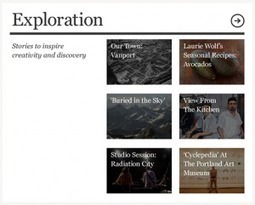 Your new post is loading...
 Your new post is loading...
Anyone who’s taken a shortcut and skipped the primer while painting a room knows the kind of results you can get. Uneven. Unpolished. The primer sets the stage for a beautiful wall.
That’s kind of the idea behind the storytelling website Primer Stories, says Tim Lillis, one of the creative minds behind the site, which mixes medium-form written pieces with lots of eye-catching visual effects.
He thinks the stories should be just long enough to prime readers on the subject – about 1,000 words — while also acting as a primer of intellectual paint.
Story topics can be ambitious, but Lillis and co-creator Joe Alterio were intent on crafting narratives that are digestible for both longform lovers and listicle lushes.
“We realized that somewhere along the line, the important ideas were losing the battle of marketability,” Alterio says. “So, how do we give them a little bit of that flash while still retaining that core, essential part of the idea?”
According to data published by the Reuters Institute for the Study of Journalism, very few people consider print newspapers their main source of news anymore. Today's most important news sources are television and online media, with social networks taking on an increasingly large role in people's news consumption.
As people turn to other media outlets as their primary source of information, print newspapers are probably best advised to accept their new role and focus on their core strengths, which are local reporting, investigative journalism and in-depth analyses of national and global affairs.
This chart shows which news sources people from five different international markets consider the most important one to them personally....
News content optimizes differently, depending on platform. At the Missouri School of Journalism, students are testing new strategies to optimize platform-specific content with a goal of creating sequential usage patterns that can be measured and monetized.
...Our hypothesis? Different content optimizes to different platforms at different points in a progressive storytelling process. For instance, slideshows, “Five Things to Know,” and other short, easy-to-consume elements resonate on mobile phones. But because mobile has varying screen sizes and optimization opportunities, video clips and data visualization might resonate better on a tablet. The web becomes a placeholder for content early in the process, and then a repository or library for the sum of a day’s work or a story’s life cycle. And then there is the core product, “the show” or the paper or the newscast. Less and less likely to be the place where news is broken, it’s where depth is provided and value added. This is to say nothing of the role of social media and of how content is parsed in platform-specific and exclusive ways....
Digital magazine publishing is increasingly within reach for all kinds of content creators — big, small, non-profit, for profit. As another way to reuse existing content and reach audiences, digital magazines might especially appeal to non-profit and public media news organizations.
At least two such organizations — ProPublica and Oregon Public Broadcasting — have launched free digital iPad magazines to showcase their reporting. The magazines are a low-cost way to gain exposure for their work because they repurpose existing digital content into a new storytelling medium. These organizations’ creative use of digital magazines shows how versatile digital magazines are, and early reactions to the publications suggest the experiments may be a success....
Forget the digital doomsayers, said Jill Abramson. “Long-form narrative is not only alive but dancing to new music.”Other prominent journalists echoed The New York Times managing editor’s optimism about thriving in a Twitter age at Boston University’s annual narrative journalism conference last weekend.Abramson said devices like tablets and iPads give long-form narrative new ways to reach new audiences.
She said her paper focuses on integrated storytelling in series like “A Year At War,” with multimedia “freshening” the story by letting readers “see, feel and almost taste” soldiers’ and families’ experiences.She added that new tools can’t trump journalism basics. Wary of “narrow specialists,” she worries that journalism schools’ new technology training may detract from traditional shoe leather reporting values....
I'm not given to hyperbole, but this is an absolutely, exceptional, must-read article by Michael Lewis in Vanity Fair... As Wall Street hangs on the question “Will Greece default?,” the author heads for riot-stricken Athens, and for the mysterious Vatopaidi monastery, which brought down the last government, laying bare the country’s economic insanity. But beyond a $1.2 trillion debt (roughly a quarter-million dollars for each working adult), there is a more frightening deficit. After systematically looting their own treasury, in a breathtaking binge of tax evasion, bribery, and creative accounting spurred on by Goldman Sachs, Greeks are sure of one thing: they can’t trust their fellow Greeks....
Is integration of the personal narrative helpful or harmful in reporting? Just like the magazine industry itself, reporting styles are evolving. Aggregated and link journalism is plentiful; yellow journalism will most likely never go away; long-form journalism holds a nostalgic power, despite increasingly Tweet-ified attention spans; and now, the era of “me” journalism appears to be here for the long haul....
|
What does Shakespeare have to do with clickbait? How much in common did ancient indigenous peoples have with the Twitter community? Was Dante’s “Inferno” the original “explainer” story The surprising answers, according to Upworthy’s Amy O’Leary, are “plenty,” “a lot,” and “but of course.” O’Leary, Upworthy’s editorial director, presented a lively session at this year’s Power of Narrative conference, making the unlikely connection, as she put it in the title of her talk, from “Scheherazade to Snapchat.” Upworthy might look like it represents the baser instincts of internet journalism, with its unwavering focus on virality: video memes, listicles, and those “explainer” articles that often feature headlines beginning with “How” or “Why.” (“How SeaWorld’s empire collapsed: a tragedy in 3 acts.”) But O’Leary was an expert defender of her business, deftly explaining the hows and whys of stories that stick, and demonstrating the ways these “new” journalism models are in fact examples of centuries-old storytelling methods that have always been a critical component of human interaction....
It’s easier to reach millions of people than ever, and great stories are doing just that.While a post on Buzzfeed or The New York Times is far likelier to get 5 million hits, a post on your personal blog can still accomplish that.It could hit the front page of Reddit or get shared tens of thousands of times on Facebook or get syndicated by a big publication.
Storytellers today have the best tools, the best distribution channels, and the largest audience in history....
Create Epic Stories with Shorthand...
New storytelling tool for journalists, writers and creative people looks very promising. It's in beta and is definitely worth exploring.
Innovative storytelling, audience engagement, and financial flexibility are key ingredients for newspapers to cope with pressures from competitors, budget constraints, and the speed at which technology is changing."It came as no surprise when The New York Times took home a Pulitzer for 'Snow Fall' - the immersive multimedia package impressed journalists and web designers alike with its seamless integration of text, audio, videos, photos and interactive graphics."The comments in "Trends in Newsrooms 2013," the World Editors Forum's report on the state of the news industry, about the attention-grabbing content, underlined the importance of stories that jump out at readers....
The Pulitzer Prize for breaking news tends to go to a massive team effort, often one in which a dozen or more reporters feed material to one, two or even three writers, who pull together the main story. Papers like The New York Times and L.A. Times used to call this the “swarm” approach to breaking news. Send a ton of reporters into the field. Make sure nothing is missed. Put your best writers on the story. That’s what makes “Veteran Kills 12 in Mad Rampage on Camden Street,” Meyer Berger’s 1949 story of a mass shooting, so remarkable. The swarm was one guy: Berger....
Great writing and storytelling inspiration for all... The Great Zucchini has a secret. And in “The Peekaboo Paradox,” Gene Weingarten exhumes the history that haunts the most popular children’s entertainer in Washington, D.C. The story, which ran in January 2006, is the best thing ever written by the Washington Post’s two-time Pulitzer winner. (Surprisingly enough, Weingarten agrees with this statement.) “A children’s performer? Really?” you might wonder as you start the piece, but Weingarten is already there, waiting for you....
A Sunday morning tweet from NYU’s Jay Rosenprovoked a conversation about why journalists call the opening of a story a “lede.” Jennifer Connic, a social media producer at NJ.com, tweeted, “I kind of like lede still. I can’t describe why, but I do. Maybe it’s my newspaper roots.” Steve Buttry responded, “I don’t think you should spell it ‘lede’ unless you can remember how molten lead smells. I can, and I don’t...”
|
 Your new post is loading...
Your new post is loading...
 Your new post is loading...
Your new post is loading...






















Refreshing approach to storytelling and journalism.